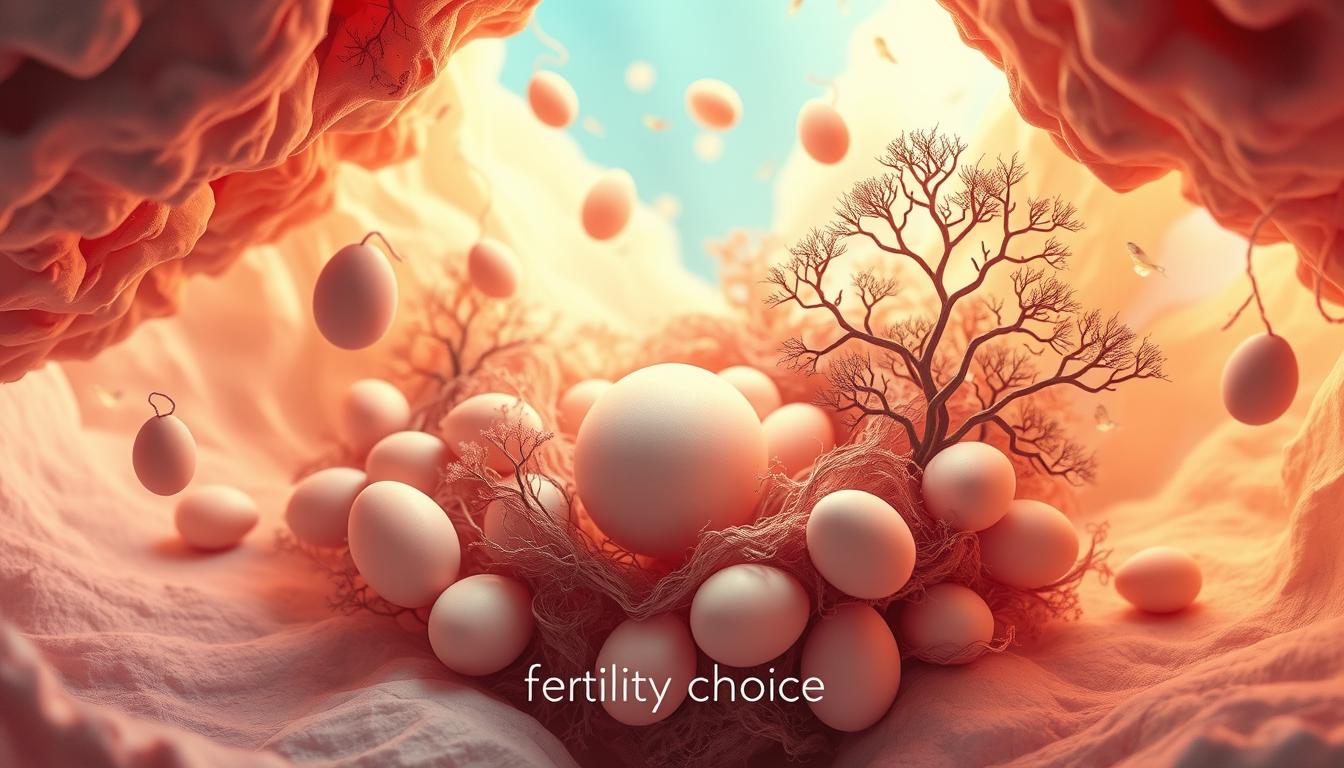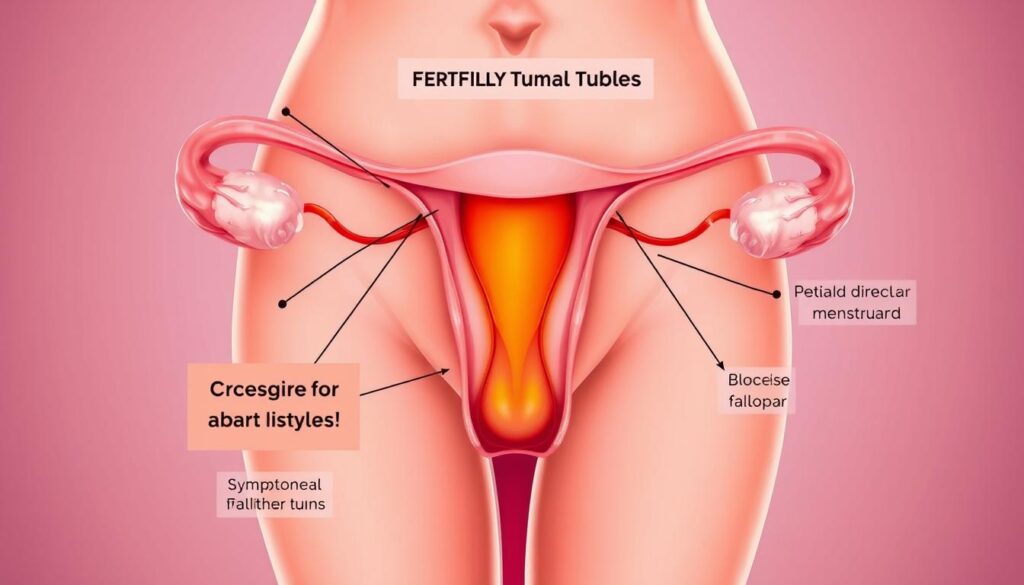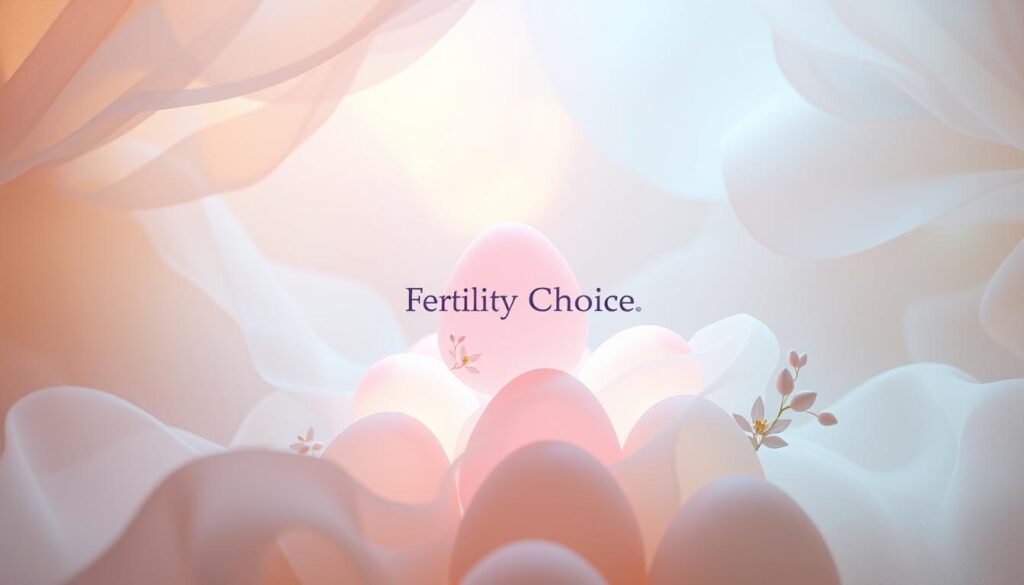
A woman’s egg reserve is key to her fertility. Knowing how many eggs she has helps her make smart choices about her health1. As women age, their ovulation count and egg reserve drop. This makes it crucial to think about these factors when planning a family1.
At birth, a woman has about 1-2 million eggs. By puberty, this number falls to 300,000-500,0001.
Blocked fallopian tubes cause infertility in about 10-15% of couples2. Surgery to fix these tubes can lead to ectopic pregnancy risks1. More than 30% of women with infertility issues have damaged or blocked tubes3.
Learning about blocked fallopian tubes can empower women. It helps them manage their reproductive health and boost their chances of pregnancy1.
The female reproductive system is complex, and egg cell production in females is key to fertility. The number and quality of eggs from the ovaries are vital for getting pregnant. Any problems with the fallopian tubes can impact fertility. The second source explains that the fallopian tubes are crucial for fertility, as they guide the egg from the ovary to the uterus4.
The fallopian tubes are essential for the female reproductive system. They help the egg from the ovaries reach the uterus. The ovary egg quantity and quality are crucial for conception. Any fallopian tube issues can affect fertility5.
Blocked fallopian tubes can be caused by pelvic inflammatory disease (PID), endometriosis, and surgical adhesions. These conditions can lead to inflammation and scarring in the tubes. This can block the tubes and impact fertility6. Knowing the causes and symptoms of blocked fallopian tubes is vital for diagnosis and treatment.
| Cause | Effect on Fertility |
|---|---|
| Pelvic Inflammatory Disease (PID) | Can cause blockage and scarring in the fallopian tubes, affecting fertility5 |
| Endometriosis | Can cause inflammation and scarring in the fallopian tubes, leading to blockage and affecting fertility4 |
| Surgical Adhesions | Can cause blockage and scarring in the fallopian tubes, affecting fertility6 |
Blocked fallopian tubes can happen for many reasons. These include common health issues, pelvic inflammatory disease, and endometriosis7. These problems can cause scarring and damage in the tubes. This can affect how many eggs a woman has and her ability to get pregnant4.
Medical conditions like pelvic inflammatory disease (PID) can block the tubes. PID is often caused by untreated STIs7. Endometriosis, where the womb lining grows outside, can also block the tubes5. Even fibroids can press on the tubes and block them7.
Even if the tubes are only partially blocked, a woman might still get pregnant naturally7. But, the risk of an ectopic pregnancy goes up. This is when a fertilized egg implants in the tube instead of the womb4. Treatments like In Vitro Fertilization (IVF) can work differently for everyone. It’s a treatment that’s tailored to each person’s needs5.
Blocked fallopian tubes can lead to infertility. It’s important to know the symptoms to get medical help7. These tubes can affect a woman’s egg reserve and ovulation count, making it hard to get pregnant. The number of eggs a woman has can also decrease, causing infertility8.
Common signs include pelvic pain, irregular periods, and trouble getting pregnant6. If you have these symptoms, see a doctor. Blocked tubes can raise the risk of an ectopic pregnancy. Getting medical help can boost your chances of getting pregnant.
Here are some important things to remember about blocked fallopian tubes and fertility:

Diagnosing blocked fallopian tubes is key for women facing infertility. It affects how eggs move from the ovaries. Tests like ultrasound and hysterosalpingography check the tubes for blockages9. These tests also look at egg production and reproductive health.
A hysterosalpingogram (HSG) is a quick test to see if tubes are blocked9. About 25% of women with infertility have blocked tubes10. The HSG can spot blockages and guide treatment.
Important things to know about diagnosing blocked tubes include:
Seeing a healthcare professional is crucial for diagnosing and treating blocked tubes9. With the right tests and treatment, women can boost their chances of pregnancy10.
Blocked fallopian tubes can stop a woman from getting pregnant. They block the path for sperm to meet the egg in the tubes11. This can also affect the number of eggs a woman has, as egg reserves decrease with age12. Treatments include surgery and non-surgical methods like IVF2.
Surgery can help restore fertility but carries risks like infection and damage to other organs11. Non-surgical treatments are less invasive but success rates vary12. It’s important to think about age, tube damage, and fertility goals when choosing a treatment2.
In some cases, reversing sterilization is possible. Success rates are higher if the blockage is closer to the uterus2. Surgery costs can be similar to an IVF cycle, depending on medical aid12. The right treatment depends on individual needs. Always talk to a healthcare professional to find the best option11.
A woman’s egg reserve is key to her fertility, decreasing with age13. The number of eggs she has affects her chances of getting pregnant. At birth, women have 1 to 2 million eggs, but this drops to 300,000-500,000 by puberty13.
Knowing how many eggs a woman has and her ovulation count is vital. This information helps choose the right fertility treatment. IVF is a common treatment for women with blocked fallopian tubes13. Other treatments can also help women get pregnant.
Here are some key statistics on a woman’s egg reserve and ovulation count:

Women should understand their fertility options and seek medical help if they have trouble conceiving. Knowing how many eggs a woman has and her ovulation count helps her make informed decisions about her reproductive health13.
Living a healthy lifestyle can greatly benefit the female reproductive system. This includes better egg cell production and more eggs in the ovaries15. Eating well is key, as it gives the body the nutrients needed for egg production16. Also, taking care of your mental health can positively impact your reproductive system15.
Some important lifestyle changes include:
By making these changes, you can actively support your reproductive health. This can also improve your overall well-being16.
| Lifestyle Change | Impact on Fertility |
|---|---|
| Healthy weight | Improves fertility |
| Moderate exercise | Improves sperm quality |
| Limited caffeine intake | Supports reproductive health |
Regular health check-ups are key for keeping fertility and health in check, mainly for women with a limited number of ova in a female. A woman’s female egg supply and egg reserves in women can be impacted by age and lifestyle2. To stop blocked fallopian tubes, it’s vital to use protection during sex and avoid infections. These can harm the fallopian tubes and cause infertility3.
Living a healthy lifestyle, like eating well and exercising, can also boost fertility. It lowers the chance of blocked fallopian tubes. Women can protect their reproductive health by getting regular check-ups and avoiding infections.
| Factor | Effect on Fertility |
|---|---|
| Age | Decreases egg reserves in women |
| Lifestyle choices | Affects female egg supply and overall health |
| Infections | Can cause blocked fallopian tubes and infertility |
By taking steps to prevent issues and living healthily, women can lower their risk of blocked fallopian tubes. This protects their reproductive health2.
If you’re feeling symptoms of blocked fallopian tubes, it’s crucial to see a doctor.
Signs like persistent pelvic pain, irregular periods, and trouble getting pregnant are warning signs. They mean you should visit your healthcare provider.
Getting a diagnosis and treatment early is key. It boosts your chances of getting pregnant. Treating issues like pelvic inflammatory disease or endometriosis can also help.
Female babies start with about 4 million eggs, but this number drops a lot over time17. By puberty, girls have around 300,000 to 400,000 eggs17. By age 30, this number falls to about 72,000, which is just 12% of the original amount17.
As women get closer to menopause, usually between 45 and 55, the egg count goes down even more. In the UK, the average age of menopause is 5117.
Seeing a doctor can help figure out the best way to tackle fertility issues. This might include treatments like IVF or other assisted reproductive technologies18. By being proactive and working with your healthcare team, you can increase your chances of having a family.
Stay Connected and Get Personalized Assistance
Thank you for reading! We hope you found this post helpful and informative. If you have any questions or need further assistance, please reach out. We’re here to help you on your journey
